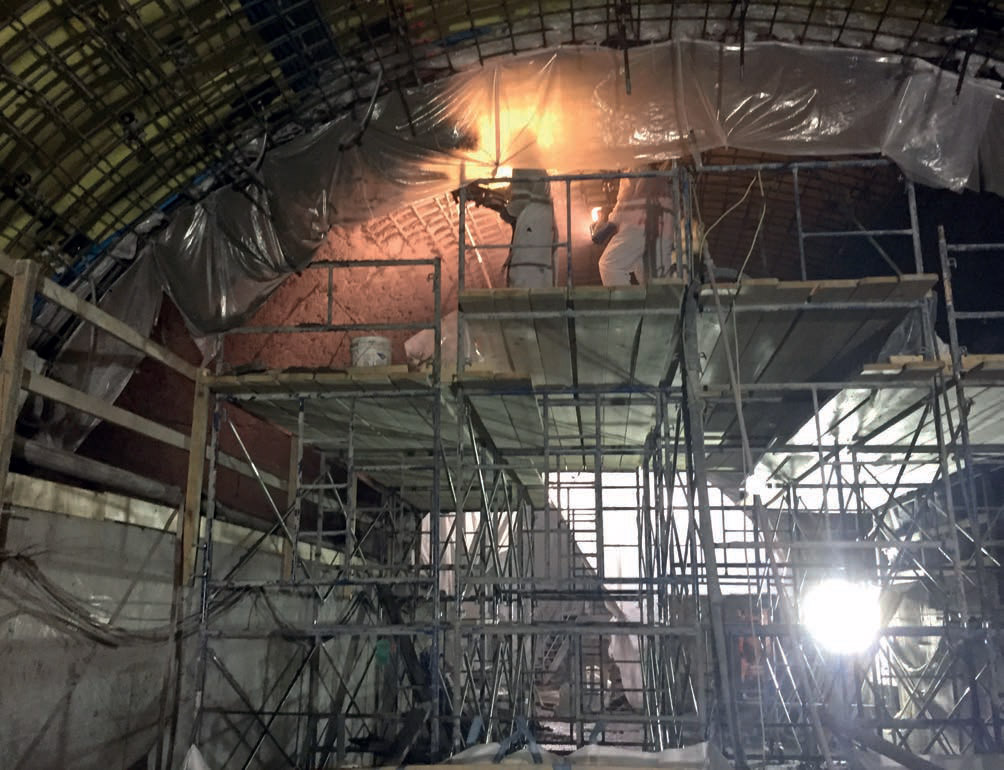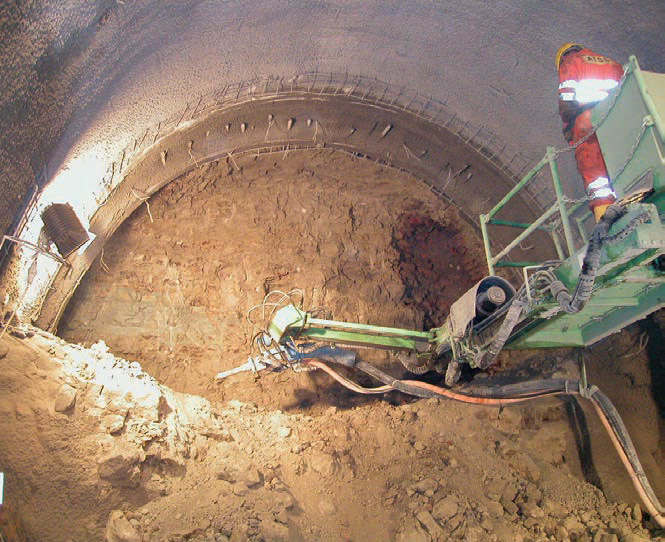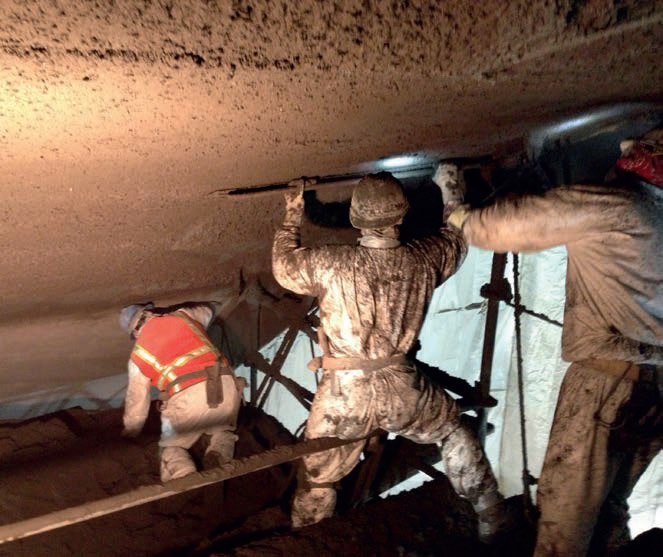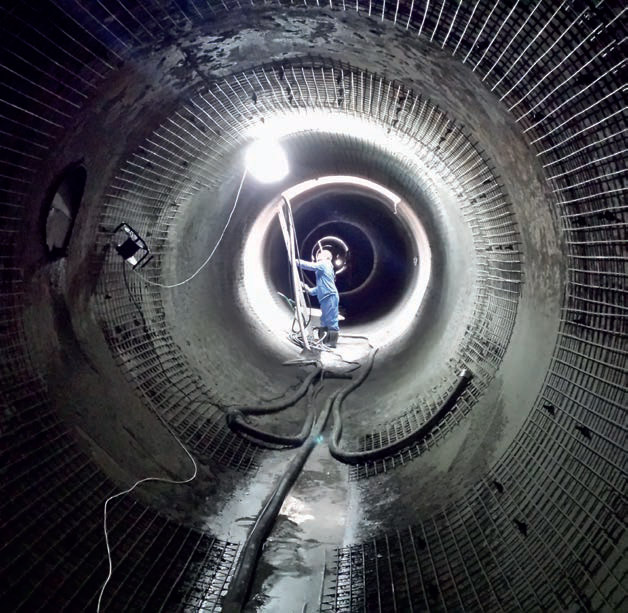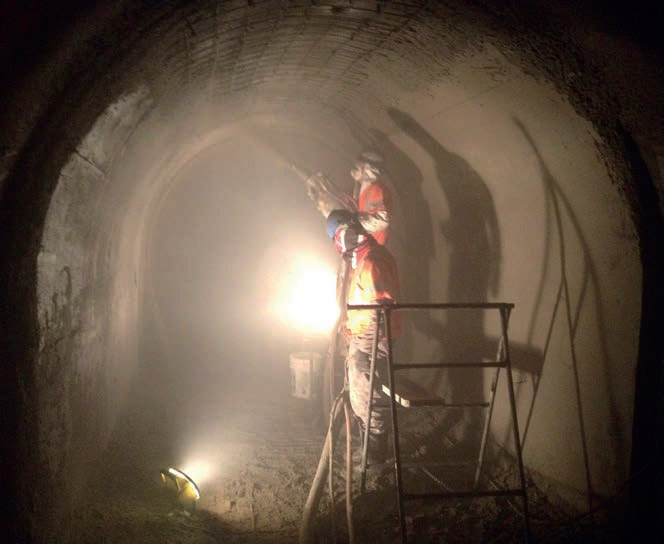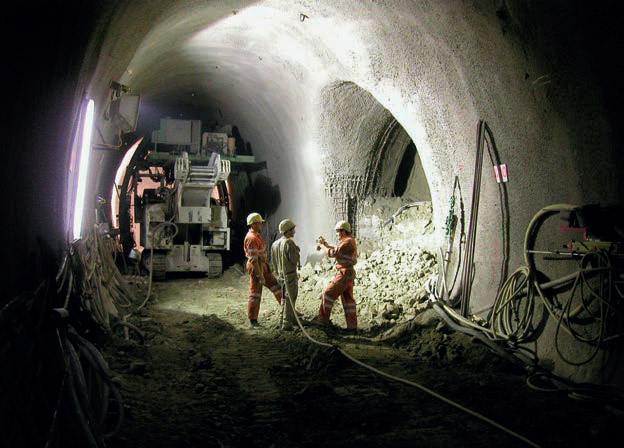ASA publishes position statements for underground shotcrete
20 February 2020Axel Nitschke, tunnel practice leader (NATM), for WSP USA , is chair of the ASA Underground Committee. He gives background on two new papers from the association
Introduction
The Underground Committee of the American Shotcrete Association (ASA) has published two new position statements covering two critical topics of underground shotcrete application – the application of shotcrete overhead and shotcreting on synthetic sheet waterproofing membranes.
The American Shotcrete Association (ASA), headquartered in Farmington Hills, Michigan, is a non-profit organisation of contractors, suppliers, manufacturers, designers, engineers, and owners with a common interest in advancing the use of shotcrete. The vision of ASA entails that “Structures built or repaired with the shotcrete process are accepted as equal or superior to cast concrete”. The mission of the ASA supporting the vision is to provide knowledge resources, qualification, certification, education, and leadership to increase the acceptance, quality, and safe practices of the shotcrete process. This mission is accomplished through the work of the ASA Committees for Education, Marketing, Membership, Pool & Recreational, Underground, Safety, Contractor Qualification, and the Technical Committee.
The two new position papers titled “Spraying Shotcrete Overhead in Underground Applications” and “Spraying Shotcrete on Synthetic Sheet Waterproofing Membranes” were developed by ASA’s Underground Committee, that is chaired by the author. The purpose of the position statements is to provide the underground and shotcrete industry guidance and a common technical understanding of the topics covered, following the mission of the Underground Committee to educate and promote the use and proper application of shotcrete in the underground construction and mining industry. The position statements were developed by two task groups, consisting of Frank E. Townsend, Axel G. Nitschke, and Lihe “John” Zhang for the overhead paper and Frank E. Townsend, Axel G. Nitschke, and William T. Drakeley for the waterproofing statement. Both papers were thoroughly reviewed and vetted by ASA’s underground and technical committee, with final approval by the ASA Board of Direction before publication, following ASA’s standard procedures.
Spraying Shotcrete Overhead in Underground Applications
In underground applications, spraying shotcrete overhead is a common and often daily operation but the successful application is challenging. Shotcrete placement propels concrete at high velocity against the overhead surface and the dynamic energy compacts the concrete in place. However, plastic shotcrete has no immediate strength. Depending on the applied thickness, the weight of the shotcrete layer can be significant. The weight of a single layer or multiple layers of shotcrete can be enough to pull the shotcrete down and cause local or large scale fallouts, which may pose a significant safety hazard and lost productivity. In addition, improper application of overhead shotcrete and other circumstances can lead to delamination and voids in the installed shotcrete.
The position statement introduces the basic elements of the adhesion and cohesion of overhead shotcrete, proper application techniques, and a discussion about so -called “re entry criteria” for working under freshly-installed shotcrete. The position paper also provides recommendations for contractors and owners from ASA’s perspective on not only how to properly apply shotcrete, but also on how to specify and inspect overhead shotcrete in underground projects, and summarises the topic in a conclusion.
Understanding the adhesion and cohesion effects is a key element of overhead shotcrete:
“During the plastic shotcrete phase, the adhesion of the plastic material to the ground surface in combination with the cohesion of the plastic shotcrete material to itself are the forces acting against the self -weight of the plastic shotcrete. Because the chemical reaction of the cement in the mixture is still in progress and has not yet created significant strength, the plastic shotcrete sticks overhead only if the conditions for adhesion and cohesion are right.”
Further key elements of preparation and execution to achieve proper conditions are discussed in more detail and typical mistakes are highlighted. Adhesion failures appear between the substrate and the shotcrete typically if the substrate is not properly prepared. While adhesion failures appear at the interface with the substrate, cohesion failures appear within the shotcrete and are primarily avoided by a proper mixture design and shotcrete placement techniques. However, cohesion failure is also possible in the substrate, e.g., in sandy conditions, and can arise due to the additional weight of the shotcrete being carried by the substrate.
Another important item is the “interlocking” effect during the shotcrete installation on irregular, blocky, or porous ground surfaces. The shotcrete interlocks mechanically, allowing the shotcrete material to fill and bridge over these irregularities.
“The use of this interlocking effect is one of the major aspects controlling the shotcrete bond when spraying in mining or tunnel applications and experienced underground nozzlemen take advantage of “reading the rock.”
The position statement provides guidance for the proper application of shotcrete overhead by covering mixture proportioning, surface preparation, the thickness of each pass, utilisation of anchors, lattice girders, and reinforcement, as well as challenges with waterproofing membranes. In addition to discussing shotcreting procedures and techniques, it also highlights the importance of qualification of the key personnel:
“Due to the technical challenges and potential safety hazards, overhead shotcrete should only be applied by qualified shotcrete nozzlemen. The nozzlemen must be properly trained, experienced, and certified as ACICertifed Nozzlemen for overhead application of wet or dry mix shotcrete.”
One of the key questions for overhead shotcrete operations regarding safety is the definition of a re-entry criteria, that allows crew movements underneath the newly installed overhead shotcrete. Although the position statement provides some general guidance it also emphasises the need for a project-specific definition and evaluation of the re-entry criteria:
“Typical values for an early compressive strength -based re entry criteria range between 150 to 500 psi (1 to 3.5 MPa) and are typically measured with a penetrometer or end beam tester. However, a re entry criteria for the general public (for example, in a rehabilitation project) should be significantly higher.” “However, it is emphasized that neither a strength nor a time based re entry criterion provides a guarantee against fallouts because fallouts are influenced by a multitude of factors, (…).”
Following the guidelines provided by the American Concrete Institute Committee for Shotcreting (ACI 506), the position statement recommends a clear specification of requirements, which includes preconstruction testing and the use of mock-ups. Mock-ups are seen as a valuable tool for the contractor and the owner, especially in complex overhead shotcrete applications.
“Preconstruction testing and mockups are highly recommended and provide an efficient tool to optimize the system before applying shotcrete at the project and are money well spent.”
“The tests should be seen as a beneficial tool to avoid safety hazards and rework during execution and not simply a contractual obligation.”
In summary, the installation of overhead shotcrete in underground applications is a challenge and requires special experience and skills to be successful. ASA’s position paper on overhead shotcrete discusses the basics of overhead shotcrete installation and provides recommendations for dos and don’ts along with guidance or the development of safe re entry criteria under shotcrete applied overhead in an underground setting. Overhead shotcrete can be executed safely and with high quality, if the process parameters defined in this position paper are consistently and correctly executed.
Spraying Shotcrete on Synthetic Sheet Waterproofing Membranes
Applying shotcrete for final linings against synthetic sheet waterproofing membranes has become more common in underground projects. The sprayed shotcrete is propelled at high velocity against the membrane and the dynamic energy consolidates the plastic shotcrete in place. However, the smooth surface and potential pillowing or vibrating of the waterproofing membrane poses a challenge compared to a shotcrete application against a stiff and rough surface.
The use of shotcrete final linings in underground applications is a standard placement technique. However, improper application of shotcrete against waterproofing membrane in a double shell system, with a separate temporary lining at the extrados and the final lining at the intrados of the membrane, can lead to poor-quality shotcrete due to delamination and voids, and produce local or large-scale fallouts, and can be the subject of technical disputes about cause and effect responsibilities.
ASA’s position paper about spraying shotcrete on sheet waterproofing membranes discusses the basic elements of the adhesion of overhead and vertical shotcrete on a waterproofing membrane, the proper application techniques, and emphasises the use of mockups. This position paper also provides recommendations for contractors and owners from ASA’s perspective, on how to properly apply, specify, and inspect shotcrete applied against waterproofing membranes.
The key technical challenge is the weight of the plastic shotcrete before it gains sufficient strength to support itself. Synthetic sheet waterproofing membranes do not adhere to the substrate of the initial tunnel lining over the entire area but are using a pattern of fixation points. The weight of the plastic shotcrete is only be supported two ways or by a combination thereof:
“Adhesive forces of the plastic shotcrete can only be transferred into the initial lining at the fixation points of the membrane or where the membrane is supported by a selfsupporting reinforcing bar cage.
If shotcrete is installed on top of sheet waterproofing membrane, the weight wants to pull the membrane down. If the only resistance is provided by the nails keeping the membrane in place, the membrane can be ripped off the nailed disks and potentially damage the membrane. During that phase, reinforcement and lattice girders provide an important element during the installation of shotcrete.
“To avoid fallouts, plastic shotcrete must be supported by other means than the adhesion of the plastic shotcrete against the membrane. If the final lining is reinforced by reinforcing bar or welded wire fabric, the weight of the shotcrete is typically supported by the reinforcement. The reinforcement, on the other hand, is either suspended from anchors or is self-supporting, typically using lattice girders. In both scenarios, adhesion to the membrane is not required to keep the plastic shotcrete in place.”
It is important to understand this concept and ensure that either the self-supporting rebar, and or the anchoring system, is strong enough. However, the weight to be carried strongly depends on the shotcreting procedures and patterns as well as the strength development of the shotcrete over time.
If fibre-reinforced shotcrete is used, lattice girders or a light reinforcement may still be required to avoid damage to the waterproofing membrane.
When using fibre-reinforced shotcrete on top of the waterproofing membrane, the potential for damaging the membrane by fibres is a frequent question. There are two different scenarios. The first scenario deals with fibre-reinforced shotcrete in the substrate. To avoid damages to the membrane typically a non-fibrereinforced smoothing layer is installed. The second scenario is applying fibrereinforced shotcrete as a final lining on top of the membrane.
“Spraying steel fiber-reinforced shotcrete does not damage or puncture the membrane because the forces acting on the fiber are not strong enough to push the fiber into the membrane and typically the fibers tend to orient parallel to the membrane on impact.”
Coordination between the membrane installer, the reinforcement installer and the shotcrete contractor is another key element. An improperly installed membrane can lead to performance issues of the shotcrete lining.
“So-called “pillowing” of the membrane (a trapped air or water pocket or unwanted undulation underneath the waterproofing preventing the proper filling of materials) between fixation points must be avoided.” “If the membrane is loosely spanning between adjacent fixation points, either because they are too far apart relative to the curvature of the arch or due to too-large outward waviness of the initial lining, the membrane may vibrate and prevent shotcrete adhesion during or immediately after application and cause increased rebound.”
As already emphasised in the overhead position statement, pre-construction mock-ups mimicking the actual conditions is considered a key element for successful shotcrete installation and it becomes more important as the technical challenges in the final construction become more complex.
“Shotcreting should be tested on a mockup mimicking the project-specific installation of the waterproofing membrane the reinforcement and lattice girder installation.”
The installation of shotcrete final linings is an efficient construction method that saves both time and cost. However, the installation of shotcrete on waterproofing membranes in underground applications is challenging and the owner, as well as the contractor, have to be aware of it and address the challenges.
“The owner should provide a design reflecting the specific challenges for a final lining applied on a waterproofing membrane.”
There is typically an interface between the waterproofing installer and the shotcrete contractor and it can also include the reinforcing bar installer. To ensure quality and avoid deficiencies, these relationships and handover requirements should be clearly defined, inspected and documented in detail by the shotcrete contractor.
As for the overhead shotcrete application, the shotcrete nozzlemen should be ACI-certified, experienced, skilled, and specifically briefed and trained for the installation of shotcrete against a waterproofing membrane. Prior to the application, nozzleman should be qualified for the project by shooting a mockup section with the waterproofing membrane. Proper shooting procedures and application sequence should be laid out in writing in the work plan and tested during the preconstruction mockup construction.
The owner and contractor should face and meet the expected challenges prior to the start of construction. Experienced staff with both are required for the successful execution of the project.
Conclusion
The recently published ASA position papers covering applying shotcrete overhead and on synthetic sheet waterproofing membranes address two technical applications of shotcrete, which are frequently subjects of discussion on underground projects. The position papers provide guidance in areas that are currently not well covered by other guidelines or generally accepted literature. ASA’s goal is to support the industry by filling these gaps. Both position papers are available for download, free of charge, on ASA’s website www.shortcrete.org under the Products/Services & Information tab.
ASA welcomes feedback from the industry and is available as a resource. If you are interested, feel free to join ASA and the ASA Underground Committee.


